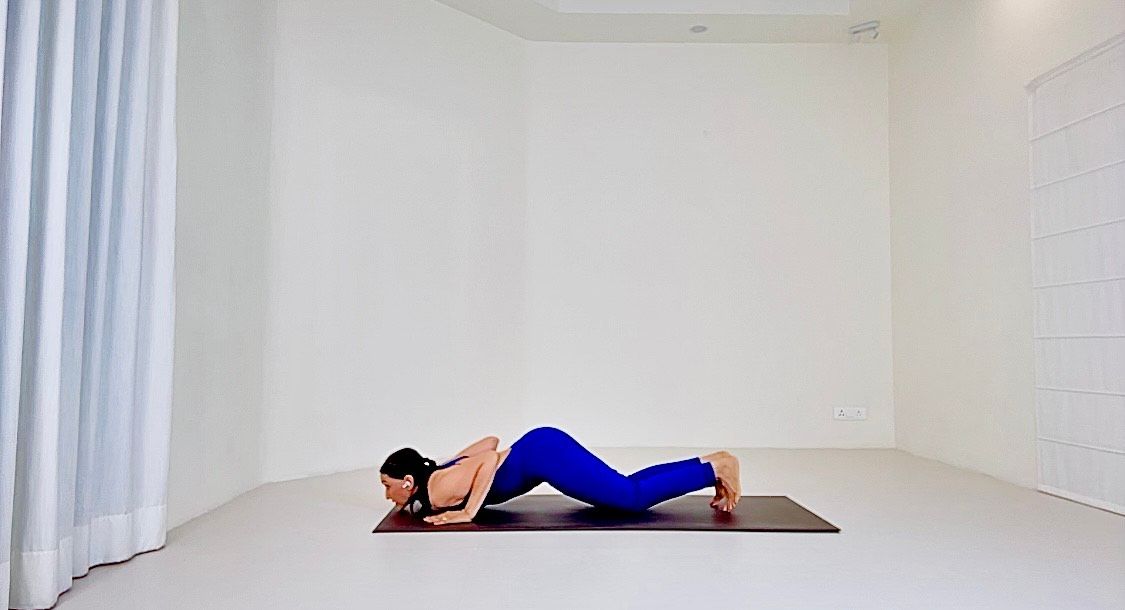People routinely comb through YouTube tutorials and websites to learn the Surya Namaskar Postures and that’s ok, however, the correct execution of these twelve postures and the hidden meanings involved, intended to balance body, mind and spirit, should really be learnt from a reliable and experienced yoga teacher.
Here is a Quick Overview of The Twelve Postures to Get One Started
Pranamasana (Prayer Pose)
We stand balanced at the top of our mat, exhaling and drawing our palms together in front of our chest in prayer position, with a feeling that we’re drawing the energy to our ‘Anahata Chakra’ our ‘Heart Center’. We should remember to keep our shoulders relaxed and gently drawn back and down.
This posture helps to centre us, in preparation for the exercise ahead.
Hastauttanasana (Raised Arms Pose)
Inhaling, we circle our arms up from the front, taking them overhead, bringing them alongside our head; then we arch back, keeping our head and arms in one plane. We should keep our awareness on the base of the throat, on the ‘Vishudhi Chakra’. If we are stiff in the back, then we should just bend back gently initiating the backbend from the top of the back. If we are more flexible, we can initiate the backbend from the mid back.
Padahastasana/Hasta Padasana (Hand to Foot Pose)
Exhaling, we bend forward from the hips, keeping our spine lengthened, and place our hands or fingertips on the floor on either side of our feet. We focus on the ‘Svadhisthana Chakra’, the ‘Sacral Center’, below the naval. Those whose hands are not reaching the floor, can either bend the knees or catch the lower legs. People with conditions like cervical spondylosis, hypertension, and vertigo, who are not supposed to drop the head down fully, should only bend down halfway, placing their hands just above their knees and keeping the head slightly lifted up.
Ashwa Sanchalanasana (Equestrian Pose)
Inhaling, we step our left leg far back, resting on the knee, shin and top of the foot. The left leg goes back far enough so that our right knee is directly over the right ankle. We relax and sink our hips towards the floor and look up. We should try and focus on our ‘Agya Chakra’/ ‘Ajna Chakra’, the point between the eyebrows.
Parvatasana (Mountain Pose)
Exhaling, we step the right leg back and align our body in an ‘upside down V’ position. We can choose to go deeper in this stretch by pressing our hands and feet firmly into the mat and lengthening our arms, legs and spine, and sinking our head closer or all the way to the floor. We can allow the lower back to arch a little, for allowing deeper extension in the spine. This posture would then be called ‘Adho Mukha Svanasana’ or the ‘Downward Facing Dog’ In this posture we try and keep our attention on the ‘Vishuddhi Chakra’, at the base of the throat.
Ashtanga Namaskara (Salute With Eight Limbs Pose)
Exhaling, we lower our knees, chest, and chin, (in this order), to the floor; So our hips are raised with chest and knees in contact with the floor. Elbows should remain close to our body. In this posture we focus our attention on the ‘Manipura Chakra’, the Navel Center.
Bhujangasana (Cobra Pose)
Inhaling we slide forward, with our chest, shoulders and head raised and arched back, while the legs and hips are on the floor. We should keep our feet together and toes lengthening out behind. Our elbows bent and drawn into the body and shoulders pressed down and back, away from the ears. All the while internal attention on ‘Svadhisthan Chakra’, the Sacral centre.
Adho Mukha Svanasana (Downward Facing Dog Pose)
Exhaling we lift our hips, forming an inverted V-shape, then stretch deeper into Downward Dog. We keep our hands shoulder-width apart and feet hip-width apart. We place equal weight on our hands and feet. Focus on the Throat Center.
Ashwa Sanchalanasana (Equestrian Pose)
Inhaling we bring our left foot forward between our hands, in one large step, (or two steps if one is not possible) pressing the right knee, shin and top of the foot into the mat. Our left knee is now directly over the left ankle. We lower our hips towards the floor and look up. We fix our internal gaze on our Eyebrow Centre, our ‘Third Eye’
Hasta Padasana/ Padahastasana (Hand to Foot Pose)
Exhaling we bring our right foot forward next to the left foot, folding forward, bending down from the hips. We touch the floor on either side of our feet with our palms or finger tips or grasp our lower legs. We draw our attention inwards to the Sacral Center, below the navel.
Hastauttanasana (Raised Arms Pose)
Inhaling we start straightening up, circling our arms up overhead from the front, then arching back, keeping our arms on either side of our head. We should stretch our entire upper body upwards and backwards while the legs and hips remain steady. We must try and keep a steady internal gaze at the base of our throat.
Pranamasana (Prayer Pose)
In the last of the twelve Surya Namaskar Steps, exhaling we return to an upright posture, bringing our palms together in front of our chest, with a feeling of gathering the energy deep in the chest in the Heart Center. We must stand balanced with the weight spread on our full feet.
Need help doing the Sun Salutation Poses with ease? Schedule an Online Yoga Class at Yoga with Sapna today!
Our Related Searches:-
Sun Salutation Yoga, Surya Namaskar Yoga, Surya Namaskar for Beginners, Sun Salutation, Surya Namaskar Steps, Surya Namaskar Poses, Sun Salutation Poses, Surya Namaskar Step by Step, Sun Salutation Steps, Sun Salutation Benefits, Surya Namaskar Benefits, Surya Namaskar for Beginners Online, Surya Namaskar Yoga Online, Sun Salutation Online, Surya Namaskar Steps Online, Surya Namaskar Poses Online, Surya Namaskar Benefits Online, Sun Salutation Benefits Online.
